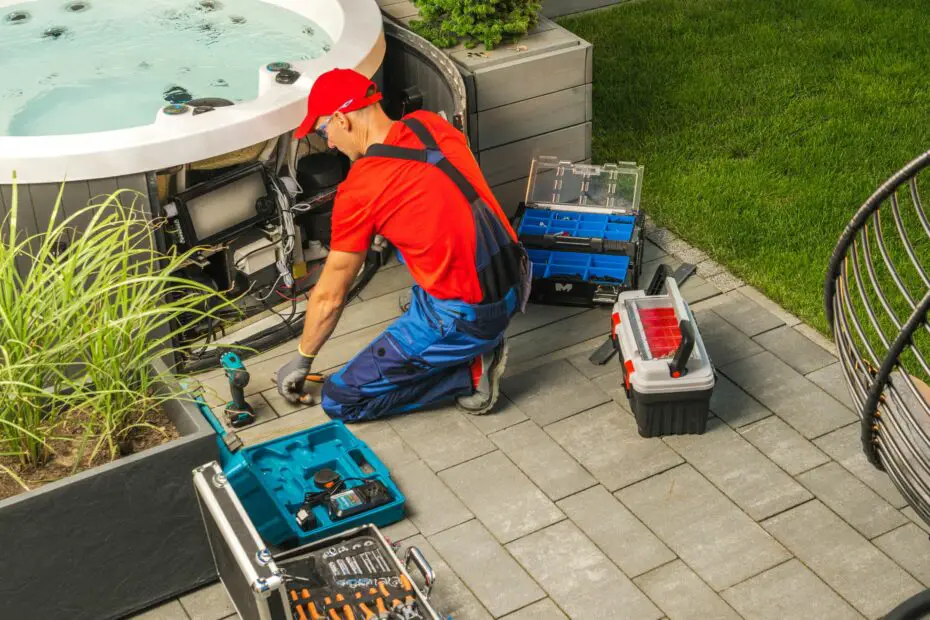Why Dogs & Inflatable Spas Don’t Mix (Yet)
Inflatable hot tubs are built with layered PVC or drop-stitch fabric that feels tougher than it looks—but a single enthusiastic claw or tooth can ruin the party. Beyond punctures, muddy paws introduce grit that stresses the pump and filter. Left unchecked, dog hair tangles around the impeller, and sanitiser levels plummet under the extra organic load. Protecting your spa isn’t just about saving money on replacements; it’s about safeguarding your pet from hot water, chemicals, and slippery surfaces.
2. Quick-Glance Prevention Checklist
| Priority | Action | Why It Matters |
|---|---|---|
| ★★★★★ | Install a rigid, lockable cover | Blocks claws, teeth, and curious noses |
| ★★★★☆ | Train a “leave it” / boundary command | Reduces constant supervision |
| ★★★★☆ | Lay a dense EVA-foam ground mat | Stops underside abrasion + adds insulation |
| ★★★☆☆ | Fit a freestanding pet gate or pen | Physical barrier without altering deck |
| ★★★☆☆ | Offer alternative water play (kiddie pool) | Satisfies the splash instinct |
3. Choosing a Dog-Safe Set-Up Location
Pick a platform, not a path. Place the tub on a level patio corner or deck zone that isn’t part of your dog’s normal zoomie route. Shield at least two sides with existing fencing, planters, or walls—cutting the access points you must police by half. If on lawn, create a 1 m gravel or paver border so digging paws never reach the vinyl wall.
See our “Inflatable Hot Tub Placement Guide” for load-bearing tips and drainage considerations.
4. Equipment Defences
Heavy-Duty Ground Mats
Invest in ≥ 10 mm closed-cell EVA foam tiles or a purpose-made hot-tub floor pad. They:
- Cushion accidental jumps (claws are less likely to puncture on impact).
- Prevent stones working up through soil into the liner.
- Add 1–2 °C of thermal insulation—saving on running costs.
Claw-Resistant Tub Covers
A simple vinyl skin cover is no match for a Labrador’s curiosity. Upgrade to:
- Tri-laminate thermal covers with an inner aluminium layer.
- Hard-shell spa lids (fibreglass-reinforced) that lock with clips.
- Inflatable lids + insulated top caps—double layer means a dog must puncture both to hit water.
Pro tip: Choose darker colours; they hide minor scratch marks and absorb sunlight for passive heating.
Removable Barriers & Gates
If fencing isn’t an option, modular exercise pens (≈ 80 cm high) wrap around a round tub perfectly. Look for powder-coated steel panels with rubber feet so they won’t rust on a wet deck. Train your dog that gates = boundary, not challenge.
5. Behavioural Solutions
Positive-Reinforcement Training
- Mark the boundary. Place a bright rope or mat 1 m from the spa edge.
- Reward distance. Treat every time your dog chooses to stay outside the line.
- Add distractions. Practice with the jets running so the novelty wears off.
Consistency beats severity; never yell around the tub (you’ll create negative water associations that backfire at bath time).
Distraction & Enrichment Strategies
- Cooling splash pool: Give your dog a personal paddling spot 2–3 m away.
- Lick mats or frozen KONG® toys: Occupy them during your soak session.
- Snuffle rugs: Scatter dinner in the yard so foraging > spa investigations.
6. Emergency “Paw-Puncture” First-Aid
Accidents happen. Keep a vinyl repair kit and follow these steps:
- Stop the leak quickly—submerge only the puncture area to locate bubbles.
- Clean & dry with isopropyl alcohol.
- Apply a pre-cut round patch (no corners to peel) and firm pressure for 2 min.
- Wait 12 h before refilling to full PSI.
- Shock-dose sanitiser to 10 ppm free chlorine; filter 1 h before bathing again.
If water spilled chemicals on your dog or they ingested spa water, call your vet or the Animal Poisons Helpline immediately.
7. Maintenance & Inspection Routine
| Frequency | Task | Notes |
|---|---|---|
| Before every soak | Run your palm along entire rim for soft spots | Early warning of delamination |
| Weekly | Rinse ground mat, check for debris under spa | Stops slow abrasion |
| Fortnightly | Clean filter cartridge & lubricate cover clips | Hair + lotion gunk hurts flow |
| Monthly | Test chemical balance after heavy dog shedding seasons | Adjust chlorine + alkalinity |
| Quarterly | Deflate, deep-clean, rotate tub 90 ° | Evens out UV and wear patterns |
8. When to Upgrade: Durable Materials & Accessories
If your dog is unstoppable, consider:
- Drop-stitch portable spas: 10-cm thick fused PVC walls rival rigid acrylic for puncture resistance.
- Secondary exterior wrap: Custom-sewn Cordura® or marine-grade canvas sleeves slip over most 4-person models.
- Stainless-steel hose guards: Replace brittle plastic outlet covers that snap when stepped on.
These upgrades can add 2–5 years to tub lifespan—often cheaper than a single vinyl-liner replacement.
Are hot tubs safe for dogs?
Hot tubs are generally not safe for dogs. The elevated temperatures of hot tub water, which typically range from 100°F to 104°F, pose a significant risk of overheating and heat stroke in dogs. Dogs’ bodies are less efficient at regulating temperature compared to humans, making them more vulnerable to the effects of high heat. Exposure to the chemicals in hot tub water, such as chlorine, can also harm a dog’s skin and coat, potentially leading to irritation or allergic reactions. Additionally, the risk of drowning is a serious concern, as dogs may find it difficult to exit a hot tub or become disoriented in the water. Given these risks, it is advisable to keep dogs out of hot tubs to protect their health and safety.
